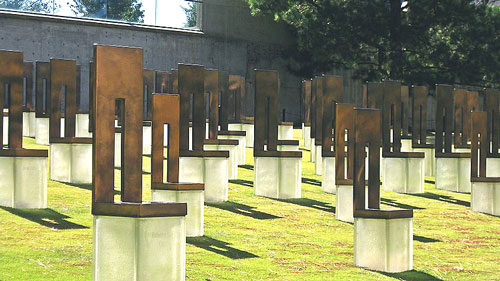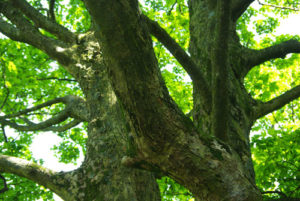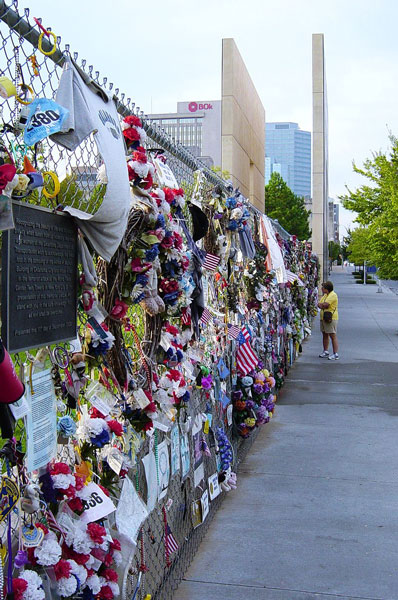
DIVING IN THE MOON
HONORING STORY, FACILITATING HEALING
Evil In The World Today
© Kate Dudding
Every time there is yet another terrorist attack, I draw comfort from this story.
People say there is a lot of evil in the world these days.
Mr. Rogers said, “When I was a boy and I would see scary things in the news, my mother would say to me, ‘Look for the helpers. You will always find people who are helping.'”
I witnessed one example of evil when I visited Oklahoma City a few years ago and went to the Oklahoma City National Memorial, the site of the bombing of the federal building on April 19, 1995.

Standing outside, I saw on the left, a large grass plot, with many bronze chairs on it, some large and some small.
On the right, I saw an old tree, gnarled and asymmetrical, but covered with green leaves.
Behind that old tree I saw a number of new trees, all the same kind and the same size, obviously planted at the same time.
All around, I saw office buildings, and in the distance, neighborhoods.
Then I went into the museum. I saw film from a traffic helicopter taken minutes after the bombing, when half of the federal building was just gone. I learned that the grass plot was the exact footprint of the federal building.
I saw The Gallery of Honor, with photos and mementos of each of the 168 victims. I learned that there was a bronze chair on the grass plot for each of the victims, 149 large chairs for the adults who were killed (including three pregnant women), 19 small chairs for the children who were killed. (There had been a daycare center in the federal building.)

I read about the 850 people who had been injured and how that old, gnarled, asymmetrical American Elm tree, originally in the parking lot of the federal building, had been named The Survivor Tree in their honor.
I read about the over 10,000 rescuers and volunteers who came to the site after the bombing, and about the one rescuer who was killed. I learned how those new trees, called The Rescuers’ Orchard, had been planted in their honor.
I learned that over 300 other buildings in OK City had been damaged by the bombing and that one third of the population of OK City knew either a victim or a survivor of the bombing.
Because a special event was going on, I was privileged to see and hear three people who had been effected by the bombing.
A survivor told of helping to find each other in the darkness of the bombed building and together finding the way out to the light. A man took off his shirt so the survivor could press it against her bleeding face. She was taken to a hospital in a hotel van. (There weren’t enough ambulances in Oklahoma City for the over 800 injured. So hotels sent their vans to help.) The hotel van driver asked, “Does anyone know the way to the Veterans Hospital?” Luckily, one survivor did.
The survivor had a friend telephone a few days after the bombing and ask, “Can I do something for you?” The survivor replied, “Thank you, but my family is with me. We’re fine.” The friend almost desperately asked again, “Isn’t there anything I can do for you?” It was then that the survivor realized that her friend needed to give, so she, the survivor, needed to receive. The survivor said embarrassedly, “Well, my kitchen floor needs mopping.” The friend gladly came over and mopped that kitchen floor.
The survivor told us that a neighbor, someone she knew to wave to, but not much more, came to her door, and offered to cut her lawn that year. The survivor told us, “Here in Oklahoma we have a long growing season. I said it was too much, just cutting my lawn this week would be enough. But my neighbor insisted, ‘I really want to do this for you.’” The survivor also agreed to receive.

A rescuer told how family and friends of victims cheered each day as the rescuers entered the site looking for more bodies. He said with amazement, “They were waiting for us to find the bodies of their loved ones, yet they cheered us.”
The rescuer told us how there were lots of out of town rescuers who joined in the search for bodies. After every shift, those rescuers went back to their cots in the convention center where they found their clothes cleaned and folded, the bed covers turned down, and a candy on pillow.
The rescuer told us, “Working at the site was rough on our clothes – so many sharp edges, so much dirt. People donated clothing for us to wear, more clothing than we needed. Other people stood in line for hours to donate blood for the survivors. City crime and fires were down by 50% for weeks after the bombing. People knew the police and fire fighters had more important work to do.”
I also heard a family member of one of the victims. Bud Welch lost his only child Julie, a charming and spunky 23 years old woman with a big heart. Bud told us, “even though I was from a family which had always been against the death penalty, for first four weeks after the bombing, I wanted the men responsible to “fry.” Then I went on a downward spiral of more and more cigarettes and alcohol for many months.
“I finally asked myself, “What do I want? A trial? Yes. Conviction? Yes. Death?
“After thinking long and hard, I realized that my desire for the bombers’ deaths was fueled by thoughts of revenge and hate, exactly what had fueled the men who did the bombing. I chose NOT to join them.”
Bud started campaigning against the death penalty. Note: Bud still wanted those men “in a cage for the rest of their lives.” But he no longer wanted them killed.
Reluctantly Bud watched father of the bomber Timothy McVeigh give a TV interview while weeding his garden. When Bill McVeigh finally looked in the camera, Bud saw a face he had seen in his mirror, the face of a father in despair. Bud vowed to meet Bill McVeigh one day and tell him that he did not hold him accountable in any way for the actions of his son.
Bud kept that promise and the two fathers worked as hard as they could to prevent the death of Timothy McVeigh. They failed but they tried together. Bud said, “I wake up every day proud. Bill McVeigh wakes up every day with a noose around his neck.”
After the event was over, I went back outside. I saw on the left, the large grass plot, with the 168 bronze chairs on it, some large and some small, and thought about the victims of the bombing and their families.
On the right, I saw The Survivor Tree, gnarled and asymmetrical, but covered with green leaves, and thought about the 850 survivors of the bombing.
Behind The Survivor Tree I saw The Rescuers’ Orchard, and thought of the thousands of rescuers and volunteers.
I looked around the city, and thought of all the residents who had known a victim or a survivor.
People say there is a lot of evil in the world these days. Two people caused all that evil in Oklahoma City.
I remember what Mr. Rogers’ mother said – to look for the helpers. In Oklahoma City, there were thousands and thousands of helpers. I say they showed that there is a lot more good in the world today than evil.
We Come Here To Remember
Those Who Were Killed,
Those Who Survived,
And Those Changed Forever.
May All Who Leave Here
Know The Impact Of Violence.
May This Memorial Offer
Comfort, Strength, Peace,
Hope And Serenity.
Inscription on the Gates of Time, Oklahoma City National Memorial
 Kate Dudding of Clifton Park, NY, specializes in true stories about people who made a difference. She has told stories at many venues in the Northeastern US. She has been commissioned to create stories by The New-York Historical Society, New York City; The Schuyler Mansion State Historic Site, Albany; The Empire State Aerosciences Museum, Schenectady; and Easton Library. Each of her four CDS has received a national award. Her most recent CD is ”Fighting For Our Rights – American Women mid-20th Century.” In 2010, she won the story slam (competition) at the National Storytelling Conference in Los Angeles. www.KateDudding.com, (518) 383-4620
Kate Dudding of Clifton Park, NY, specializes in true stories about people who made a difference. She has told stories at many venues in the Northeastern US. She has been commissioned to create stories by The New-York Historical Society, New York City; The Schuyler Mansion State Historic Site, Albany; The Empire State Aerosciences Museum, Schenectady; and Easton Library. Each of her four CDS has received a national award. Her most recent CD is ”Fighting For Our Rights – American Women mid-20th Century.” In 2010, she won the story slam (competition) at the National Storytelling Conference in Los Angeles. www.KateDudding.com, (518) 383-4620
